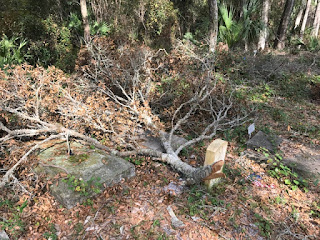Post-Irma HMS Florida Field Update, 9/22
We've been up and down the east coast to check on sites in state parks, historic cemeteries, and historic structures. Here's some highlights from the field this week.
Sarah Miller: Old Stone Warf, New Smyrna Beach
This week I checked in with Dot Moore in New Smyrna. She led us to a site impacted by a pontoon boat that floated during flood conditions up and over the National Register listed 1769 coquina wharf. In addition to the pontoon boat, a boat house and dock now sit mangled between the two parallel coquina foundation blocks that extend into the Intracoastal Waterway. This site dates to the Andrew Turnbull's British period settlement (1767-1777) that was built into a St. Johns Period shell midden. It will be one thing to see how they remove the boat- hopefully by crane and not by dragging it back into the water over the intact coquina foundation. The other issue will be how the mangled dock/boat house is removed. The City is taking the lead by consulting with the Department of Environmental Protection on the best way to remove the boats and debris with minimal impacts to the site.
Emily Jane Murray: Shell Bluff Landing, GTM Research Reserve, Ponte Vedra Beach
I received a call from the GTM Research Reserve about erosion at Shell Bluff Landing. Another National Register listed site, it consists of a dense shell midden spanning 6,000 years and a coquina well built by a Minorcan and dating to around 1800. I have visited the site twice since the storm, once at low tide to document the erosion and again at high tide to see the ongoing impacts. Irma caused a lot of the midden to wash up over the site - something we didn't see with Matthew. The site has lost up to 6 feet in some areas, and continues to erode
with high tides. The riprap and part of the site are in knee-deep water
still at high tide. We're still experiencing extreme high tides from the water Irma dumped on us as well as from Jose and Maria pushing water towards the coast. We'll continue to monitor the site as well as work with the Reserve and the Bureau of Archaeological Research to mitigate site damages.
Robbie Boggs: San Sebastian Cemetery, West Augustine
I headed out to check on San Sebastian Cemetery, an African-American cemetery in West Augustine. After spending so much time recording the headstones last year, I was anxious to see how it fared during the hurricane. A large amount of limbs came down during the storm and lie across vaults, headstones and curbing. The downed limbs and branches are especially dense on the west side of the cemetery. Some of the graves are not accessible due to downed branches. A major clean up will need to occur in order to remove the blanket of branches.
Words and images by FPAN Staff members where noted.
Sarah Miller: Old Stone Warf, New Smyrna Beach
This week I checked in with Dot Moore in New Smyrna. She led us to a site impacted by a pontoon boat that floated during flood conditions up and over the National Register listed 1769 coquina wharf. In addition to the pontoon boat, a boat house and dock now sit mangled between the two parallel coquina foundation blocks that extend into the Intracoastal Waterway. This site dates to the Andrew Turnbull's British period settlement (1767-1777) that was built into a St. Johns Period shell midden. It will be one thing to see how they remove the boat- hopefully by crane and not by dragging it back into the water over the intact coquina foundation. The other issue will be how the mangled dock/boat house is removed. The City is taking the lead by consulting with the Department of Environmental Protection on the best way to remove the boats and debris with minimal impacts to the site.
Emily Jane Murray: Shell Bluff Landing, GTM Research Reserve, Ponte Vedra Beach
Robbie Boggs: San Sebastian Cemetery, West Augustine
I headed out to check on San Sebastian Cemetery, an African-American cemetery in West Augustine. After spending so much time recording the headstones last year, I was anxious to see how it fared during the hurricane. A large amount of limbs came down during the storm and lie across vaults, headstones and curbing. The downed limbs and branches are especially dense on the west side of the cemetery. Some of the graves are not accessible due to downed branches. A major clean up will need to occur in order to remove the blanket of branches.
Words and images by FPAN Staff members where noted.






